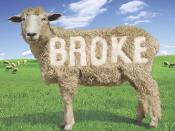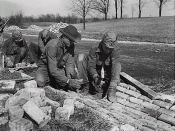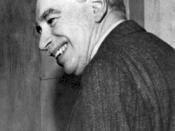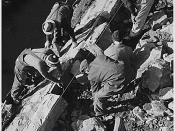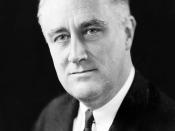President Franklin Delano Roosevelt of the United States faced a dilemma. The American economy was in shambles. As the president, Roosevelt had to solve the problems and he relied on one man's theories to pull him through. John Maynard Keynes was an important British economist during the twentieth century. His theories had a major impact on FDR's perspective on the American government's economy. In 1933, the United States, quite out of keeping with its constitution, embraced Keynesian economics with the announcement of the "ÃÂNew Deal.' The New Deal programs were created to combat the Great Depression. The following essay will discuss Keynes' theories regarding coping with a recession and how the government should be involved. Upon acknowledging these theories and studying some of the New Deal programs, it becomes obvious that Keynes economically influenced FDR. Lastly, this essay will analyze the New Deal's success.
Keynes made several theories regarding how a government should get involved during a country's recession.
The two most important ones are; the supply and demand theory, and the deficit spending. Keynesian economics is defined as the "use of government spending to encourage economic activity by increasing demand for goods."àKeynes was opposed to the ideas that supply generated demand. He demonstrated that "supply often exceeded demand, therefore leading to unemployment, idle resources, social conflicts, and needless waste of human potential"à(Kuttner: 1991, 26). This was close to reality. During the Great Depression, many factories were out of business. Products were not being produced, and nearly one out of every four Americans was unemployed. Men who could have been spending their time working, or doing something productive, now spent their time waiting outside soup kitchens. It was true to say that during the depression, human potential was wasted. In Keynes' Collect Writings (1989), he wrote that "if demand fall short of supply, output may have to run down to bring them back into balance, hence the possibility that the economic system bay find itself in stable equilibrium"æat a level below full employment"à(CW VII: 1989, 30). This meant that when demand decreases, supply must decrease in order to find the point of equilibrium. When supply decreases in order to find the new point of equilibrium, prices will rise. At this point, when supply must drop again, workers are laid off. In other words, as long as supply drops, unemployment will increase. With this theory, Keynes tried to explain the economic slump that many countries fell into after World War I (1914-1920). Demand for weapons and military equipment diminished severely. Factories laid-off workers that were not needed anymore.
In 1929, the American economy suffered a downturn. Many people were unemployed and had little money to spend. Business cut production, and workers were laid off. Keynes believed, in order for a government to get back into its feet, it must be willing to "deficit spend,"ÃÂ in order to stimulate demands for goods and services. Money must be given to consumers so it would be possible for them to buy goods and fuel economic growth. Keynes believed that "direct state intervention to promote and subsidise new investments would be the only means of escape from prolonged and perhaps interminable depression"ÃÂ (CW XXI: 1989, 59-60). This meant that unless the government was willing to spend money on the economy to stimulate growth, the country's economy would suffer from depression longer than it was supposed to. In short, the government has to spend its way out of depression, otherwise, they would be trapped in a vicious cycle of poverty. Keynes had difficulty directly influencing FDR regarding deficit spending. However, other members in the White House were easier to influence. In turn, those men sold Keynes' idea to the President. "Deficit spending was essential, but it had to be at least a certain amount"ÃÂ (Schlesinger: 1960, 407). For instance, if the government was only willing to spend $200 million per month, the nation would stay at the bottom of depression. If $300 million per month were spent, the country's economy would improve, whereas $400 million would bring the country back into recovery. "By arguing that an economy was like a mighty engine that needed the fuel of deficit spending to keep running at full throttle and create jobs for the Great Depression's unemployed masses, Keynes convinced Roosevelt to abandon his long-held belief in balanced budgets."ÃÂ Roosevelt created programs designed to help the economy during the depression with the help of Keynes' theories. Keynes was a strong believer in putting money in into the hands of the people. The New Deal practiced the exact strategy. The Civil Works Administration (CWA) began on November 8, 1933. Like all other programs, it was to provide temporary jobs. About four million people were employed raking leaves, shovelling snow, and working in parks. It ceased in March 1934 after spending $740 million. Roosevelt was putting money into the hands of people by giving them jobs. Since some people had money to spend now, they were able to buy more items. When more goods were bought, companies would produce more because demand was increasing. To increase supply, more workers were hired. This would be known as the "ÃÂtrickle down effect,' meaning that once the government gives its citizens money to spend, the economy will naturally recover itself. This wouldn't be possible unless the government was willing to spend money. The Works Progress Administration (WPA) created on May 6, 1935 was one of the largest programs Roosevelt created. Like all other New Deal programs, its goal was to slowly bring the economy back to pre-1929 levels. "The WPA spent $11 billion and employed over eight and one half million citizens over 1,410,000 projects between 1935 and its termination on 30 June 1943."ÃÂ The Civilian Conservation Corps (CCC) was another New Deal program with 250,000 immediate jobs designed for men aged 18-25. The wages were $30 per month and $25 would be sent home. Jobs in the CCC included reforestation, road construction, flood control, and development of national parks. This program made use of Keynes theories again because human potential was not being wasted. Jobs were being created, thus curbing unemployment, and money being sent to the families meant that the "ÃÂtrickle down effect' would be put to use. The men's families would have money to spend, hence that would prevent social conflicts or riots.
Roosevelt created many other programs just like the ones listed above, all with the same intentions; to bring the American economy back to pre-1929 levels. With the creation of all these programs, it was obvious that deficit spending must have occurred. The Public Works Administration, which created jobs such as the building of roads and public buildings, spent $3.3 billion. In 1934, the gross national debt was $34 billion. Without Keynes and his economic theories, which helped Roosevelt create the New Deal programs, America might have never gotten out of the depression. If Roosevelt ignored Keynes' theories, and American economy would not be where it is now at the present moment.
FDR was successful in applying Keynesian economics to his New Deal programs. No matter what Roosevelt did, had he not given up his beliefs of keeping a balanced economy, it would have failed. However, the President was persuaded to give deficit spending a try. Until 1930, "federal deficit never exceeded 5% of the gross domestic product. However, in 1936, the federal deficit was 13% of GDP."ÃÂ Between the years 1933 and 1935, the economy improved, though it was not up to pre-1929 standards. During those two years, the gross national product rose from $74.2 billion in 1933 to $91.4 billion in 1935. "Manufacturing salaries and wages increased from $6.24 billion in 1933 to over $9.5 billion in 1935, with average weekly earnings going from $16.73 to $20.13. The money supply, as currency and demand deposits, grew from $19.2 billion to $25.2 billion."ÃÂ Before the New Deal was put into play, the unemployment rate was at 24.5 percent. One in every four Americans was out of a job and with little hope of getting one. After the New Deal was implemented, the unemployment rate during 1935 fell to 20.1 percent and 14.3 percent in 1937.
One could say that America was on its way to recovery. Before 1929, the unemployment rate was at 3.2 percent. Roosevelt noticed the change in the economy between 1933 and 1935. Still being a firm believer of laissez-faire government, he started to cut back on some programs. The WPA experienced the largest cut. As a result of Roosevelt's attempts of having a balanced budget, the economy slipped rapidly during the winter of 1937-1938. The unemployment rate jumped to 19 percent in 1938. Due to the recession of 1937-1938, Roosevelt started spending more money again on the New Deal programs. In July 1938, the economy began to recover, and in 1939, statistics showed that the economy regained 1937 levels. Nevertheless, "it wasn't until 1941 that the unemployment rate fell to 13.8 percent"ÃÂ (Kuttner: 1991, 27). That, however, would have been attributed to the United States involvement with the oncoming World War II.
In conclusions, Franklin Delano Roosevelt of the United States was able to defeat the Great Depression with the help of a British economist, John Maynard Keynes. Relying on Keynesian economics, Roosevelt created the New Deal program in order to combat the depression. Though FDR was a firm believer in balanced budgets and laissez-faire, he managed to follow Keynes theories regarding supply and demand, and deficit spending. During 1936, the federal deficit was 13 percent of GDP. Using Keynes' two most important theories, Roosevelt created "ÃÂmake-work programs' such as the Civilian Conservation Corps and the Public Works Administration. Roosevelt took these theories and applied it to his programs correctly. As a result, the economy improved and the unemployment rate was lowered. Though it did not restore the economy back to pre-1929 levels, it was a start. In fact, the New Deal was so successful that even though the economy has had four separate recessions since 1937, the economy did not collapse in the scale of 1929-1939. This is because a "set of safeguards, mostly put in place during the New Deal in the 1930's, that makes a 1930-style collapse of a nation's financial system highly unlikely"ÃÂ (Peterson: 1981, 18).
Bibliography 1. Keynes, John Maynard. The Collected Writings of John Maynard Keynes. London: Macmillan, for the Royal Economic Society, 1989.
2. Kuttner, Robert. The End of Laissez-Faire. New York: Alfred A. Knoph Inc., 1991 3. Peterson, Wallace C. Silent Depression. New York: W.W. Norton & Company, 1981.
4. Schlesinger, Arthur Jr. The Politics of Upheaval. The Age of Roosevelt. Boston: Houghton Mifflin Company, 1960.
5. Taller, Terry. Marketing, A Canadian Perspective 2nd Edition. Toronto: McGraw-Hill Ryerson Limited, 1989.
Websites: 1. Landry, Peter. Biographies. http://www.blupete.com/Literature/Biographies/Philosophy/Keynes.htm 2. Rothschild, Michael. Closing the Loop. http://www.bionomics.org/text/resource/articles/closing_the_loop.html 3. http://www.libarts.sfasu.edu/history/134_Unit%207B.html 4. http://mciunix.mciu.k12.pa.us/~udhsweb/aphistory/file1012.htm
